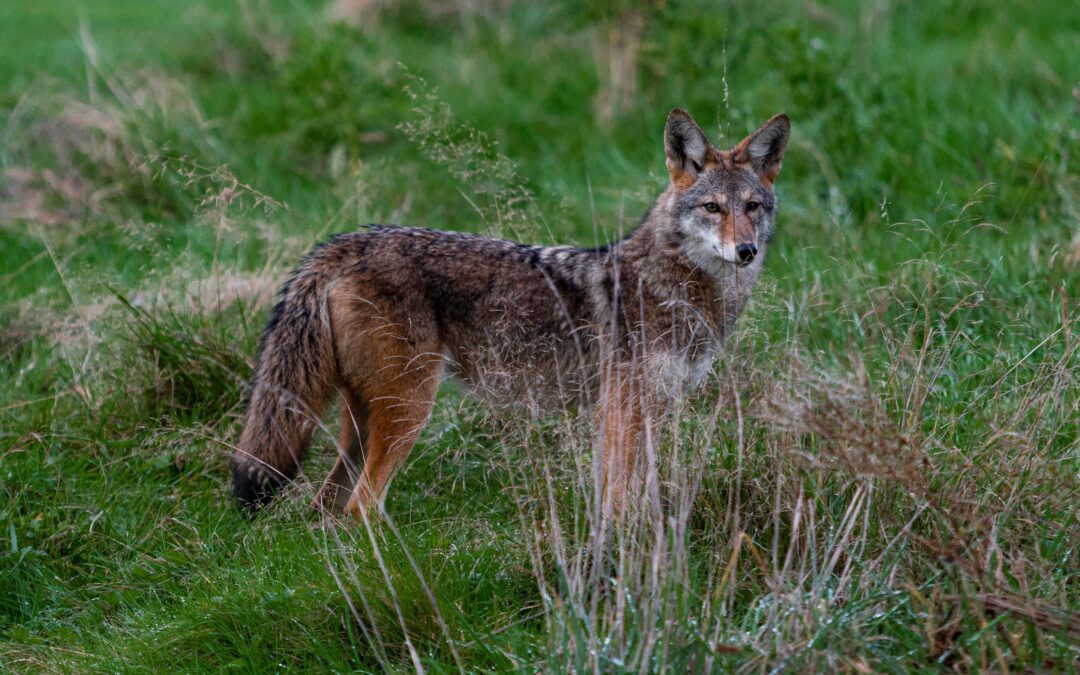It seems like coyotes are everywhere these days. Sightings of them in urban and suburban neighborhoods have increased in the past few years. A slew of recent encounters in Massachusetts have resulted in a multitude of news reports and social media posts highlighting the tragedy of snatched dogs and missing cats, and warning pet owners to be more vigilant. In the month of August alone, a coyote was spotted in the Jamaica Plain neighborhood of Boston strolling down the street with a small dog in its mouth, a woman and her dog were attacked during a morning walk around their apartment complex in Fall River, a 9-year-old chihuahua was grabbed from his yard in Milford, and another small dog was taken during a trail walk in Hopkinton.
Shrinking habitats and food sources as well as a greater number of people working from home, increasing neighborhood refuse footprints and creating more frequent opportunities for interaction, are among the theories for the increase in coyote sightings and encounters. According to Project Coyote, most interactions with coyotes in urban areas result from the presence of a dog and/or from intentional or unintentional food availability. Although coyotes are naturally timid and fearful enough of people to avoid interaction, they often react very differently to our dogs. Depending on the size of the dog a coyote may perceive them as either a threat or as potential prey. Whether your labrador or shepherd is seen as a threat to a coyote’s litter or competition for a potential mate, or your chihuahua or shih tzu looks like an appealing evening meal, the best way to avoid an attack is to minimize the likelihood of interaction.
The key to ensuring the safety of pets is for owners to adjust their behavior and take these extra steps to keep their animals out of harm’s way.
- Be aware that some dogs may be drawn to coyotes. Teaching your pets to respect and not harass or chase wildlife is an essential component of keeping them safe. Often curious or playful dogs will instigate interaction with a coyote, only to have the coyote blamed when that interaction goes awry. NEVER encourage or let your dog chase or play with a coyote and see the graphic for what to do if you encounter one while out on a walk or in your yard.
- Do not leave your pets unattended. Whether or not your dog or cat is skilled at maintaining space with wildlife, it is important to be present and aware of the surroundings at all times when your animals are outdoors. Leashing your dog or cat is yet another step in protecting your four-legged family member. Free-roaming animals are often considered by wildlife as part of their ecosystem. Your presence (particularly at the other end of a leash) will both remind and/or physically commit your pet to maintain a safe distance simultaneously deterring the possible approach of a coyote or other wildlife.
- Adjust your walking/outdoor schedule. Avoid walking your dog during the twilight hours of the morning and evening (just before sunrise and after sunset). Coyotes are most active at night, avoiding walks during these times, keeping close tabs when your pets are in the yard after dark, and wearing a headlamp or carrying a flashlight when outdoors with your pet at night are all great ways to discourage interaction. Installing motion sensor lights in your yard can also help detract unwanted visitors. You can further protect your pup by keeping them closer to you than usual (especially during breeding and whelping seasons from late winter to early fall), forgoing the use of flexi-leashes which offer little control in an emergency, avoiding walks near bushy areas or “edge zones” where a coyote might be hiding, and walking with other people and/or larger dogs.
- Clean up attractants. Bird feeders, accessible trash, and fruit trees are magnets for rodents and other small mammals, and in turn coyotes. Coyotes are also known to eat fruit. Cleaning up spilled seed from feeders, ensuring your trash containers and compost are secure, and removing fallen fruit and water sources will help make your yard less attractive and reduce the chance of an encounter. Also, resist the urge to feed your pet outdoors, as pet food can be another big attractor for coyotes.
- Try A Coyote-Deterring Gadget or Coyote-Proof Fence. Coyote-deterring gadgets, like anti-coyote collars and jackets (typically made of Kevlar with spikes), as well as coyote-proof fences, can add another layer of protection and peace of mind. It’s difficult to find convincing statistics on their overall effectiveness, so it’s important not to skimp on the other precautions mentioned above.

Coyotes are an essential part of our ecosystem, helping to keep it healthy and diverse. As omnivores, they are often referred to as “nature’s clean-up crew,” reducing the population of rodents in our cities and towns and scavenging on dead animals. These skillful foragers, when left unhindered, mate for life and have significant family bonds. Like it or not, coyotes are part of our community. The best way to manage their impact and protect our pets is through awareness and preventative action on our part.
Note: If you or your dog is bitten or scratched by a coyote, immediate medical or veterinary care is imperative. Any attacks should be reported to your state’s wildlife agency or local animal control officer as soon as possible.

